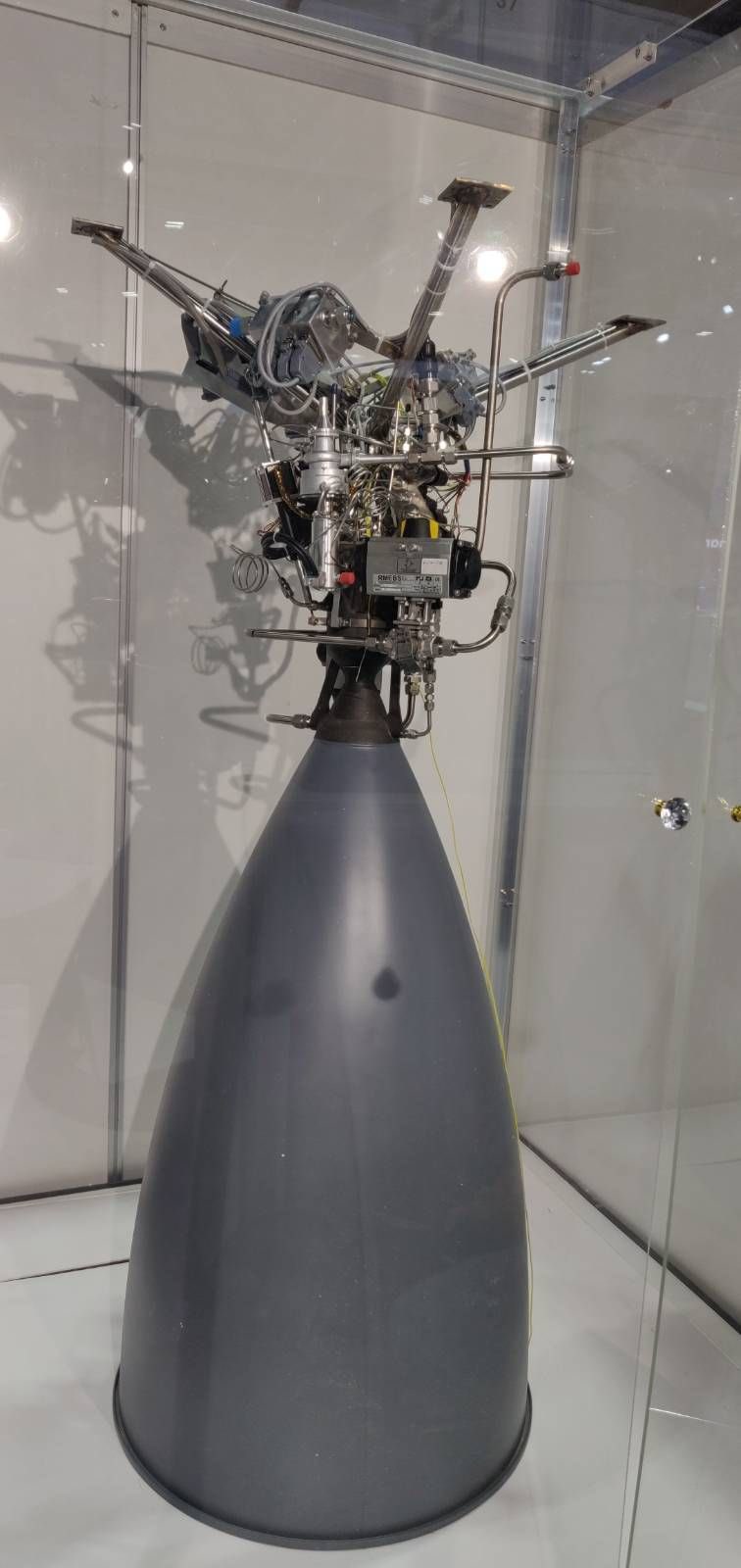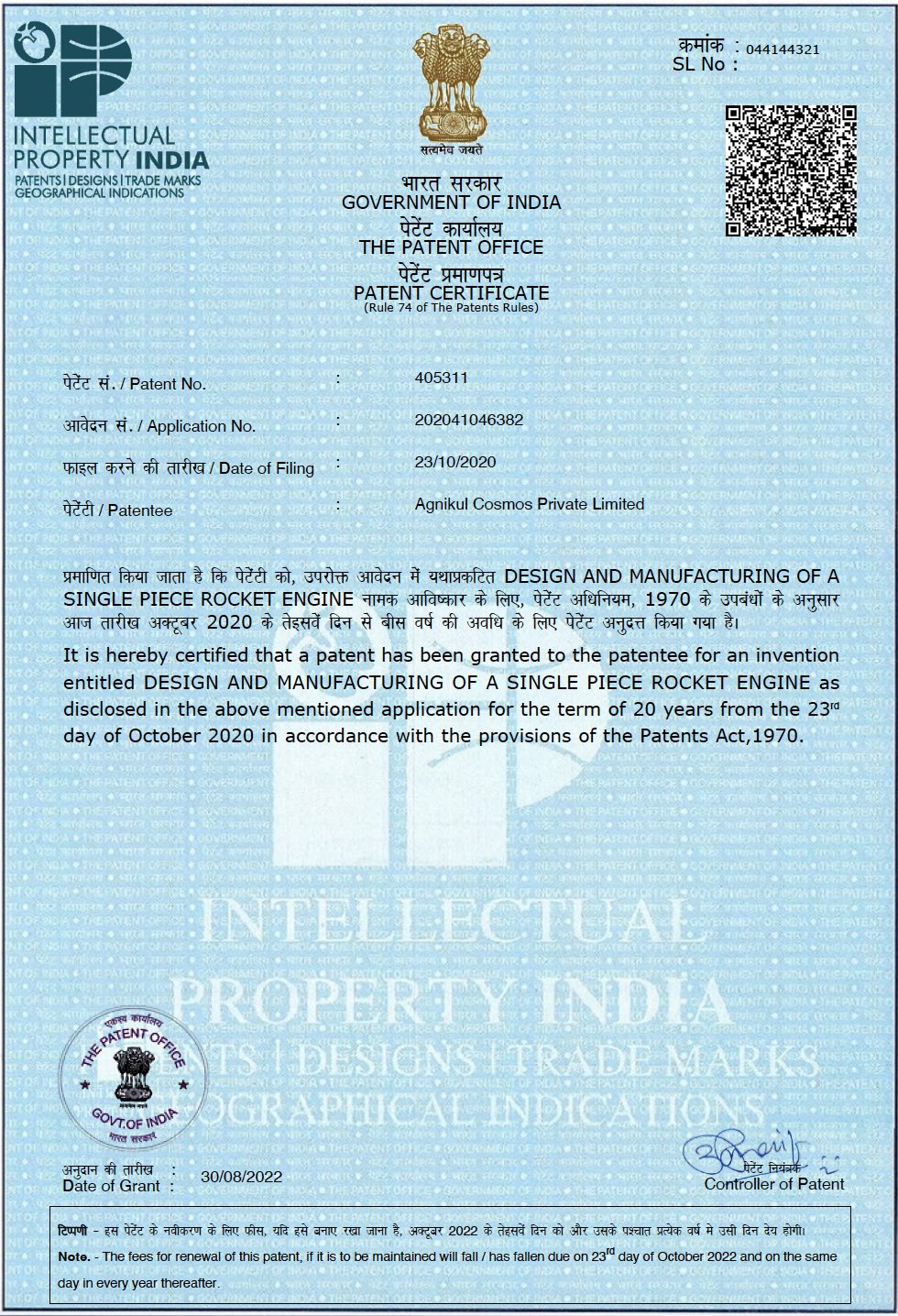Indian space startup Agnikul Cosmos was granted a patent for the design and manufacturing of its single-piece, 3D printed rocket engine. Comprising the main five components of a rocket engine and produced as a single part in one run, the higher stage semi-cryogenic liquid propulsion engine can be built in less than 96 hours and was designed to support the company’s satellite launch vehicle called Agnibaan but could also serve satellites and other space exploration vehicles.
 Agnikul Cosmos’ single-piece 3D printed engine. Image courtesy of Agnikul Cosmos via Twitter.
Agnikul Cosmos’ single-piece 3D printed engine. Image courtesy of Agnikul Cosmos via Twitter.Under conventional manufacturing practices, a rocket engine has at least 100 assembled carefully using techniques such as welding, where the workforce, equipment and cost requirement is high. Like many space technology companies, Agnikul believes that assembling the engine components using traditional processes can be tedious and cumbersome, so it identified the need for a single integrated propulsion engine with an optimized design manufactured with 3D printing effectively used in space vehicles. This led the Chennai-based small rocket company to apply for a patent for its 3D printed engine in late 2020.
Almost two years later, the Indian patents office issued the patent for the invention, which aims to provide a highly reliable single-piece, a lightweight integrated engine for space vehicles. According to the company, the engine comprises a combustion chamber to burn the fuel, an injector plate to inject the fuel into the combustion chamber, an igniter to ignite the fuel mixture, a nozzle to pass the hot gas to produce thrust, and cooling channels for regenerative cooling.
However, in the original document published by the Office of the Controller General of Patents, Designs and Trade Marks, Agnikul doesn’t specify whether the single-piece engine also includes other subcomponents of rocket engines. And while Agnikul’s founders have been posting information about their latest milestone on social media, fellow space industry experts have also inquired whether the engine is really “fully” 3D printed, as the company states. In particular, Tim Berry, head of manufacturing and supply chain at California space startup Launcher, asked in one of Agnikul’s posts whether “tubing, valves, electronics, etc. are all fabricated as one piece?” Adding that if it’s just the nozzle, chamber, and injector, then “it’s not a full rocket engine and is also not a new discovery.”
Berry might be alluding to the fact that in the last few years, other space startups have also publicized the creation of 3D printed rocket engines. For example, last April, Launcher demonstrated the full thrust of its E-2 engine––which boasts a fully 3D printed chamber––for the first time; Rocket Lab has also been known to use 3D printed engines, while rocket engine manufacturer Ursa Major focuses solely on developing 3D printed rocket propulsion systems and UK-based startup Orbex has even commissioned AMCM to build a large-volume 3D printer for manufacturing its rocket engines in one piece. With so many companies turning to 3D printing for their rocket propulsion and space agencies like NASA and ESA advancing their own rocket engine technology through additive manufacturing, it seems like there is tough competition ahead.
However, Agnikul is sure that it can offer a rapid turnaround on its rocket engines since “everything is 3D printed in one shot.” The startup, incubated at the Indian Institute of Technology Madras (IIT Madras) Research Park, has already hit impressive goals thanks to its one-piece 3D printed rocket engines. Since 2019, the company says it has “automated” the process of engine making, with zero assemblies involved in its creation, and has already tested its 3D printed engine in 2021.
 Agnikul Cosmos’ patent for its 3D printed rocket engine. Image courtesy of Agnikul Cosmos.
Agnikul Cosmos’ patent for its 3D printed rocket engine. Image courtesy of Agnikul Cosmos.By using laser powder bed fusion and high-grade aerospace materials, like copper and its alloys, Inconel, Monel, and titanium, all of the engine’s components can be integrated during the build process, specifies Agnikul.
Since there are no bolts, screws, or welds, the engine is extremely light (between five and six kilos) compared to engines of similar thrust rating, which can weigh up to 25 kilos. So by utilizing 3D printing, Agnikul believes it will help reduce the mass of space vehicles, the cost of the launching vehicles, and even the cost of the mission. Furthermore, manufacturing the engine as a single piece helps identify errors much easier when compared to traditionally assembled multiple-component engines. Therefore qualification is easier and quicker, described by the startup in its patent specifications section.
As it happens with just about every industry leveraging additive manufacturing, batch production becomes much quicker, and the time required to assemble a multi-component part decreases. Also, Agnikul stated that with the machining work and human intervention reduced, they managed to speed up the turnaround time of the manufacturing process to three days and qualify the engine for flight within a week. This quicker turnaround time in engine fabrication could make the assembly process quicker and eventually help increase the launch frequency.
Commenting on this latest achievement, Agnikul Co-founder and CEO Srinath Ravichandran expressed on social media that “When we started the journey of designing an engine, we did not know the extent to which 3D printing could help us. Now, after multiple successful firings, 3D printing seems to literally be the best choice for rocket engine making. Incredibly lucky to have a team who evolved this original design from scratch in-house, simulated every aspect of it, got it manufactured pushing metal sintering to its very limit, and eventually tested it multiple times.”
 Agnikul Cosmos’ Rocket Factory – 1 unveiled. Image courtesy of Agnikul Cosmos.
Agnikul Cosmos’ Rocket Factory – 1 unveiled. Image courtesy of Agnikul Cosmos.Agnikul is looking forward to the test launch of its Agniban rocket by the end o,f 2022, which will carry around 100 kg of payload into a 700-km-high orbit for clients sometime next year. In the meantime, the startup partnered with 3D printing technology firm EOS India to expand the potential of its 3D printed rockets and sub-systems and opened a new facility, the Rocket Factory -1, to 3D print its rocket engines at scale, and has already set up EOS’ 3D printers on site, allowing it to create the hardware it needs in-house.
Subscribe to Our Email Newsletter
Stay up-to-date on all the latest news from the 3D printing industry and receive information and offers from third party vendors.
You May Also Like
World’s Largest Polymer 3D Printer Unveiled by UMaine: Houses, Tools, Boats to Come
The University of Maine has once again broken its own record by unveiling the largest polymer 3D printer in the world. Surpassing its 2019 achievement, the new Factory of the...
Changing the Landscape: 1Print Co-Founder Adam Friedman on His Unique Approach to 3D Printed Construction
Additive construction (AC) is much more versatile than it seems, at first: as natural as it is to focus on the exciting prospect of automated home construction, there’s far more...
Gorilla Sports GE’s First 3D Printed Titanium Cast
How do you help a gorilla with a broken arm? Sounds like the start of a bad joke a zookeeper might tell, but it’s an actual dilemma recently faced by...
3D Printing Webinar and Event Roundup: April 21, 2024
It’s another busy week of webinars and events, starting with Hannover Messe in Germany and continuing with Metalcasting Congress, Chinaplas, TechBlick’s Innovation Festival, and more. Stratasys continues its advanced training...





























